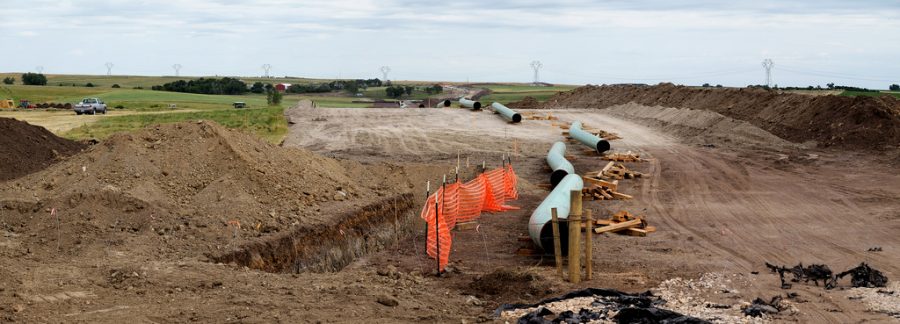Dakota Access Pipeline protesters met with violence
Photo via Google under Creative Commons license
Construction of the Dakota Access Pipeline was met with protest.
September 30, 2016
The year is 2016 and Native Americans are still fighting to protect their land.
The North Dakota Access Pipeline (DAPL), also known as the Bakken Pipeline, is expected to be over 1,000 miles long, connecting with the already existing Bakken and Three Forks areas in Patoka, Illinois. DAPL is being built by the Dakota Access, LLC, a unit of the Texas-based Energy Transfer Partners. The pipeline will transport domestically produced oil to oil refineries.
The big concern with the pipeline is that it could break at any time and contaminate the Missouri River, one of the largest water sources in the country. The Missouri river is located less than a mile away from the Sacred Rock Reservation. The Sacred Rock Reservation is “the site of the largest gathering of Native Americans in more than 100 years. Indigenous people from across the U.S. are living in camps on the Sacred Rock reservation,” according to the article “Life in the Native American oil protest camps” published on the BBC website.
The Sacred Stone is referring to the DAPL as a black snake, referencing an old Lakota prophecy of a “black snake crossing the land, bringing with it destruction and devastation,” according to Sacred Stone Camp’s online FAQs.
On Sept. 3, the Standing Rock Tribe, another local tribe affected by the pipeline, published a press release stating that the construction company bulldozed the gravesites of Native Americans. “Sacred places containing ancient burial sites, places of prayer and other significant cultural artifacts of the Sacred Rock Sioux Tribe were destroyed Saturday by Energy Transfer Partners,” Tribal Chairman David Archambault II wrote. “This demolition is devastating. These grounds are the resting places of our ancestors. The ancient cairns and stone prayer rings there cannot be replaced. In one day, our sacred land has been turned into hollow ground.” The Sioux filed a lawsuit against the U.S. Army Corps of Engineers.
Things turned violent when attack dogs were unleashed on the peaceful protestors. Private security hired by DAPL’s construction company, mostly used the dogs as an intimidation tactic. One woman, however, allowed her dog to bite a protester in the face.
Twitter user zellie (@zellieimani) tweeted out an image of said dog with the caption “that is someone’s blood on that dog’s mouth. That is blood on America’s hands.”
On Sept. 9, a joint statement was released by the Department of Justice, the Department of the Army, and the Department of the Interior. The statement demanded that the pipeline’s construction was to be halted for an indefinite amount of time, stating “The Army will not authorize constructing the Dakota Access pipeline on Corps land bordering or under Lake Oahe until it can determine whether it will need to reconsider any of its previous decisions…construction of the pipeline on Army Corps land bordering or under Lake Oahe will not go forward at this time. The Army will move expeditiously to make…we request that the pipeline company voluntarily pause all construction activity within 20 miles east or west of Lake Oahe. Furthermore, this case has highlighted the need for a serious discussion on whether there should be nationwide reform with respect to considering tribes’ views on these types of infrastructure projects. Therefore, this fall, we will invite tribes to formal, government-to-government consultations on two questions: (1) within the existing statutory framework, what should the federal government do to better ensure meaningful tribal input into infrastructure-related reviews and decisions and the protection of tribal lands, resources, and treaty rights; and (2) should new legislation be proposed to Congress to alter that statutory framework and promote those goals.”


